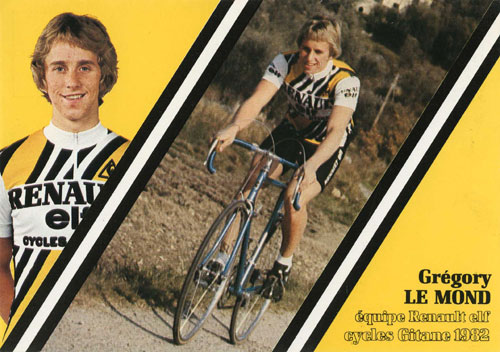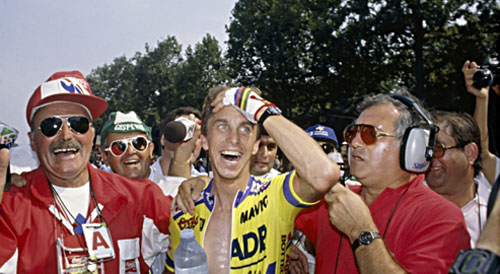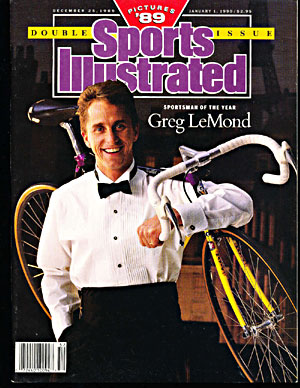|
Too
often
I
find
myself
writing
an
essay
in
which
I
heap
posthumous
praise
on
someone
I've
admired:
my
heartfelt
farewell
to
Hall
of
Fame
pitcher
Tom
Seaver,
"Saying
Good-bye
to
a
Boyhood
Hero,"
or
"Tom
Petty:
A
Charmed
Rock
'n'
Roll
Life,"
where
I
delve
into
an
American
cultural
treasure
and
personal
touchstone.
Now it's July and that means the Tour de France, so I want to celebrate a hero of mine who is still with us, one of our country's greatest athletes, a titan of cycling, a paragon of integrity, and, by all accounts, a stand-up guy: Greg LeMond.
I'm not the only one.
There's a new film about LeMond, The Last Rider,
directed
by
Alex
Holmes.
The
documentary,
playing
in
select
theaters
around
the
U.S.
this
month,
focuses
on
LeMond's
long
road
to
victory
in
the
1989
Tour
de
France
after
a
near-fatal
hunting
accident
in
1987.
Like
Hollywood,
the
sports
world
loves
a
comeback
story;
LeMond's
remains
one
for
the
ages.
In a statement, director Alex Holmes said: "The Last Rider is a celebration not just of athletic talent but of the power of love to enable us to realize our potential, and sometimes even to achieve that which the world thinks is impossible."
Yes, a celebration!
Greg's
story
is
worth
celebrating.
It
teaches
and
inspires.
(Born
June
26,
1961,
he
celebrated
his
62nd
birthday
last
month:
happy
birthday,
Greg!)
The Last Rider inevitably competes with the ESPN Films 30 for 30 classic, Slaying the Badger,
a
biopic
which
premiered
in
July
2014
and
is
easily
one
of
the
best
sports
docs
ever
made,
a must-watch.
ESPN's
film
took
a
different
angle;
its
title
refers
to
Frenchman
Bernard
Hinault,
the
tenacious
5-time
Tour
de
France
winner
nicknamed
"The
Badger"
whom
LeMond
beat
to
win
his
first
Tour
in
1986.
It
was
far
more
complicated
than
that,
though:
Hinault
and
LeMond
were
teammates
and
close
friends.
This
new
film's
title
speaks
to
the
fact
that
Greg
LeMond
remains
the
only
American
to
win
the
Tour
de
France
(subsequent
American
winners
Lance
Armstrong
and
Floyd
Landis
were
stripped
of
their
titles
when
it
was
found
that
they
were
drug-cheats.)
Greg
may
be
the
last
rider
to
have
won
the
Tour
clean,
but
more
on
that
later.
Unlike
our
home-grown
sports,
cycling
may
not
be
familiar
to
many
American
readers.
In
the
early
20th
century,
America
had
a
thriving,
well-moneyed
velodrome
racing
circuit.
Wintertime
crowds
packed
indoor
tracks
in
Chicago,
Detroit,
Minneapolis,
Newark,
and,
most
of
all,
New
York's
Madison
Square
Garden.
But
the
sport
vanished
after
World
War
II,
replaced
by
football
and
basketball.
And the French, Belgians, and Italians owned road-racing. Greg was a pioneer. When he won the Tour de France in 1986, he wasn't just the first American to do so, he was the first non-European winner. Let me offer a few insights into the sport to convey the greatness of Greg LeMond's achievements.
There
are
many
kinds
of
road
races,
some
take
a
day,
some
weeks.
In
a
time-trial,
each
rider
heads
off
individually
against
the
clock,
but
in
many
races,
especially
big
multi-day
tours,
riders
compete
as
a
team.
Strategy
abounds
and
I
could
write
a
treatise
on
the
complexities
of
squad
composition
or
the
sometime
alliances
struck
between
rivals.
Most
important
to
understand
is
that
due
to
aerodynamics,
cyclists
in
a
group
move
much
faster
than
lone
riders.
The
main
group,
called
the
peloton,
can
sustain
astonishing
speeds,
in
part
because
the
riders
rotate
the
work
of
leading,
where
wind
resistance
is
greatest.
That's
why
the
peloton
usually
catches
a
breakaway.
Relatedly,
each
team
has
its
leader,
its
best
rider
for
whom
the
others
work,
i.e.
the
leader
will
draft
behind
his
"lead-out"
teammates,
thereby
saving
his
legs
for
decisive
attacks.
That's
the
way
it's supposed to work.
The
Tour
de
France,
or
simply
"the
Tour,"
is
one
of
cycling's
three
so-called
Grand
Tours,
the
others
being
the
Giro
d'Italia
and
the
Vuelta
a
Espa帽a.
Each
entails
21
days
of
cycling,
known
as
stages—three
weeks
of
racing
with
rest
days
on
two
Mondays.
The
Tour
covers
about
2,100
miles,
which
averages
out
to
a
tidy
100
miles
of
pedaling
per
day,
but
some
stages
are
far
longer,
as
much
as
140
miles.
Now,
I
don't
know
how
much
cycling
you've
done,
but
100
miles
is
a
daunting
distance;
even
at
a
leisurely
pace
over
gentle
topography
with
coffee
breaks
and
a
stop
for
lunch,
a
century,
as
cyclists
call
it,
makes
for
a
very
long
day
in
the
saddle.
Try
hammering non-stop against your rivals as you traverse endless switchbacks up and over the Pyrenees or Alps!
And it's not just how far but how fast the riders go. Since 2007, the winner's average speed over the Tour's 2,100 miles has been just under 25 miles per hour. Get on your Schwinn or your $5,000 carbon-fiber road bike and try to maintain 25 mph for 30 minutes then tell me how you feel.
From
the
outset,
Greg
LeMond
was
a
winner.
But
at
every
third
or
fourth
step
in
his
career,
adversity
beyond
his
control
thwarted
him.
As
a
15
year-old
brand
new
to
the
sport,
he
won
the
first
11
races
he
entered.
He
won
the
American
National
Junior
Road
Race
Championship
in
1977
and
the
UCI
Junior
World
Road
Race
in
1979.
When
he
was
selected
for
the
U.S.
Olympic
team
at
18
he
was
the
youngest
cyclist
ever
to
make
the
squad,
but
America's
pointless
boycott
of
the
1980
Olympics
snuffed
his
chance
to
make
history.

In 1981, LeMond turned pro and immediately turned heads. The French
press loved this talented American who quickly learned to converse in their
language. In 1983 he won the UCI Road World Championship, a one-day
race which measured 167 miles that year. At 22 he was the best cyclist on
the planet.
In his first Tour de France, in 1984, he finished third, donning the white
jersey for the young rider classification, recognition for the best debut. The
next year he could have won the Tour but, without giving away the intrigue
of Slaying the Badger, that rule about a team riding in support of its
strongest cyclist was brazenly ignored. So he made history by winning the
1986 Tour.
Then, while out hunting in 1987, his brother-in-law mistook him for a
quarry and blasted him with a shotgun, perforating his neck, lung, heart,
and liver with 60 lead pellets. Doctors said LeMond was 20 minutes from
death, having lost 65% of his blood. Lodged in spots too dangerous to
operate, such as the lining of his heart, 35 of those lead pellets remain in
his body, slowly poisoning him.
Overcoming his harrowing ordeal and the attendant havoc it wreaked on
his fitness, LeMond returned in 1989 to re-conquer Paris (and the rest of
France.) Even though you know he wins the '89 Tour it doesn't spoil
anything, because it's how he wins which will thrill you.

Coasting from his Tour triumph in July, Greg rode to victory a second time
at the UCI Road World Championship in August. And then he won the
greatest road race of them all a third time in 1990, hoisting the winner's
trophy over his head atop the podium in Paris!
The 35 shotgun pellets in LeMond's body hastened his retirement. Initially,
his youth and superb cardiovascular shape enabled him to return to
winning form, but, then as now, the harder he exerts himself the more
those insidious projectiles titrate lead into his system. But something else
forced Greg to call it quits, another adversity beyond his control which
thwarted him.
Shortly after he returned to cycling to regain its summit, a seismic shift
rumbled through the peloton; by the early 1990s, the average rider's power
output, measured in watts, jumped—massively. Riders previously at the
bottom of the standings were now generating as many watts as the winners
on past stages. What happened? Superior nutrition? New insights into
training?
EPO had hit the streets—a synthetic version of the hormone erythropoietin
developed for anemia patients in order to stimulate red blood cell
production. It was a crazy time in cycling. Riders like Marco Pantani, Jan
Ulrich, Bjarne Riis, Alberto Contador, and, of course, Lance Armstrong
smashed course records—when they weren't dying in their sleep. Since it
was all done in secret, no one knew exactly how much EPO to take. The
cyclists were guinea pigs.
Elite endurance athletes have astonishingly low resting heart rates; when
their blood became too dense with red blood cells, their hearts simply
stopped in deep sleep. Doping cyclists now set their alarms for 3 AM,
hammered an hour on a stationary bike to get the blood flowing, and then
went back to sleep! Hmm, dozens of healthy young riders mysteriously
dying in their sleep….
Meanwhile, Greg returned to defend his Tour de France title in the best
shape of his life and was dropped . . . by the peloton. It was the beginning
of the doping era and almost every subsequent Tour winner would be
tainted, disqualified, banned, or all of the above.
Even before he retired, LeMond courageously went on record against
performance-enhancing drugs in cycling. He was rocking a very big, very
lucrative boat. His outspoken warnings cost him dearly, especially when he
called out Lance Armstrong's massive fraud in 2001. A vindictive monster
by anyone's definition, Armstrong set about to methodically destroy
LeMond and his business interests, particularly Greg's successful
partnership with Trek Bicycle Corporation who had manufactured LeMond
Bicycles since 1995. Trek also sponsored Armstrong, then a media
-dominating darling and money machine for his backers. The sinister
Texan used his leverage to get Trek to sever ties with LeMond. Along with
much of the press, the zombie Pharmstrong cultists pilloried LeMond in
every online forum (these were people who knew as much about cycling as
I do about double-entry accounting—no, actually less since I can perform
basic arithmetic.)
Along with his opposition to performance-enhancing drugs, LeMond also
warned the cycling community quite early in the game about mechanical
doping—the use of tiny electric motors hidden inside bike frames. Once
again, Greg took a ton of abuse, his critics leveling the usual anonymous
complaints—"he's just a hater"—until female Belgian cyclist Femke Van
den Driessche had a problem with her bike at the 2016 UCI Cyclo-cross
World Championship and officials noticed electrical wires hanging from
the frame. Now how did a motor get inside my bike? Oops..
I first became dimly aware of professional cycling and its then-only
American star, Greg LeMond, in my senior year of high school. That was
1984. I began riding a metallic blue Fuji "Sports 10" which I bought from a
friend and proceeded to modify until it resembled a true road bike (to
include ditching the shift levers on the handlebar stem and installing
Shimano levers on the frame's downtube, as well as buying a pair of
chromalloy pedals and shiny stainless steel toe clips.) On summer
Saturdays I often rode the hour it took me to pedal from my house in
Valley Stream to my pal Mark's house in bucolic Muttontown, a beloved
odyssey of my youth.

Since that happy day I brought it home in July 2017 from an eBay seller in
Connecticut, I've been riding a 1996 LeMond Bicycles Tourmalet, so named
for the fearsome Pyrenees mountain pass, the Col du Tourmalet, where
Greg attacked in 1990 to make up 5 minutes on race leader Claudio
Chiappucci, thereby sealing his third Tour de France victory. It's a steel
-frame bike exquisitely painted in a delicious red. Today's feather-light
carbon-fiber frames make it seem 'Old School." A less generous description
might be "heavy dinosaur," but it's a joy to ride—comfortable, smooth,
dependable, and light-years better than my old Fuji. When I'm not
powering it over the rolling hills of central New Jersey, I keep it in my
living room so I can ogle its classic lines, its cheerful colors emblazoned
with my hero's name and the World Champion's rainbow stripes.
Framed on one of my walls is a copy of the December 25, 1989 issue of Sports Illustrated with Greg LeMond on the cover in bowtie and tux sans
jacket, his bike jauntily slung over his left shoulder as he beams the
winning smile of Sportsman of the Year. More inspiration, more
celebration.

Cycling's doping-stained history has sadly vindicated LeMond. In the light
of what we always knew, as well as revelations in hindsight, his
achievements look more and more impressive. It hasn't been an easy road
for Greg LeMond, but he has always ridden it with integrity and class. He's
been one of my heroes for a long time. Still is. His life is worth celebrating.
|